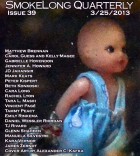The setting feels so perfect. You live in Maryland now, right? What is your connection to Portland?
Yes, I’m in Maryland now. Go Terps! But the connection to Portland was personal. My former girlfriend moved there after finishing graduate school in 2010. At the time, I was teaching full-time on a quarter system at a private college in VA, and so I was fortunate to be able to visit her every season. Though the periods were short, I got to experience the state and city. Before visiting and as an East Coaster, my knowledge of Portland was cursory at best. It didn’t go beyond coffee, rain, and Sasquatch. I eventually taught at Portland Community College this past fall, which gave me insight into the student population, unique culture, and many things Portland such as Powell’s Book Store, Voodoo Donuts, and Forest Park.
The modular structure with the numbered sections seems to parallel the character’s list he is making to himself. How did you decide on this structure?
Well, I think one of the first stories I read in college where things were sectioned off was in Faulkner’s “A Rose for Emily.” As a naive undergraduate, I remember asking the instructor about the function of dividing a short story into sections. It seemed strange, and as someone who was also taking creative writing courses, I was apt to ask, “We can do that?” I don’t remember my teacher’s response, but it was less than satisfactory, and my creative writing instructor never seemed to question it. As a Japanese major, I had to read a lot of translated fiction. For whatever reason, the translators often times marked transitions with simply * * * between sections. This was a habit I picked up from them, and, oddly enough, something that my fellow writer and colleague Andrew Gretes happened to utilize as well from workshopping stories. Our discussion of this “technique” led us to believe it sometimes seemed a natural way to signal to the reader the shift. I don’t know if it was a translator’s way to signal the shift or something peculiar to Japanese translations into English. But I know Mishima and Chekhov, though it could be the translators’ choices, sectioned things off with numbers. To this day, I’m not entirely sure why, but I think, much like punctuation marks, it has its function and draws the reader’s eyes toward the text. Well, that was longwinded enough … Honestly, it seemed like an appropriate thing to do given the lessons one inevitably learns when moving to a new environment. I’d also say that the regular prose format didn’t seem appropriate for what the story was trying to do. By numbering the lessons, it seemed more self-contained, more final. And I suppose that was part of the lesson of the lessons the narrator learned: this idea that you cannot alter the past, that you move forward continually, sometimes mercilessly. Lastly, there is really no particular reason I wound up with seven.
I love the idea of cats both as a cure for the narrator (and possibly his mother) and as a target for projection of the narrator’s own lessons. Would you say you’re a cat or dog person?
I’m a dog person, for sure. I hold no particular prejudice against cats, except for one, which peed on my pillow. You know who you are. If he had had a pillow, I would have retaliated. But all joking aside, I’m lucky that my Labrador, Duke, now 14.5 years old, can still wake me up in the middle of the night to sniff bushes.



 The core workshop of SmokeLong Fitness is all in writing, so you can take part from anywhere at anytime. We are excited about creating a supportive, consistent and structured environment for flash writers to work on their craft in a community. We are thrilled and proud to say that our workshop participants have won, placed, or been listed in every major flash competition. Community works.
The core workshop of SmokeLong Fitness is all in writing, so you can take part from anywhere at anytime. We are excited about creating a supportive, consistent and structured environment for flash writers to work on their craft in a community. We are thrilled and proud to say that our workshop participants have won, placed, or been listed in every major flash competition. Community works.